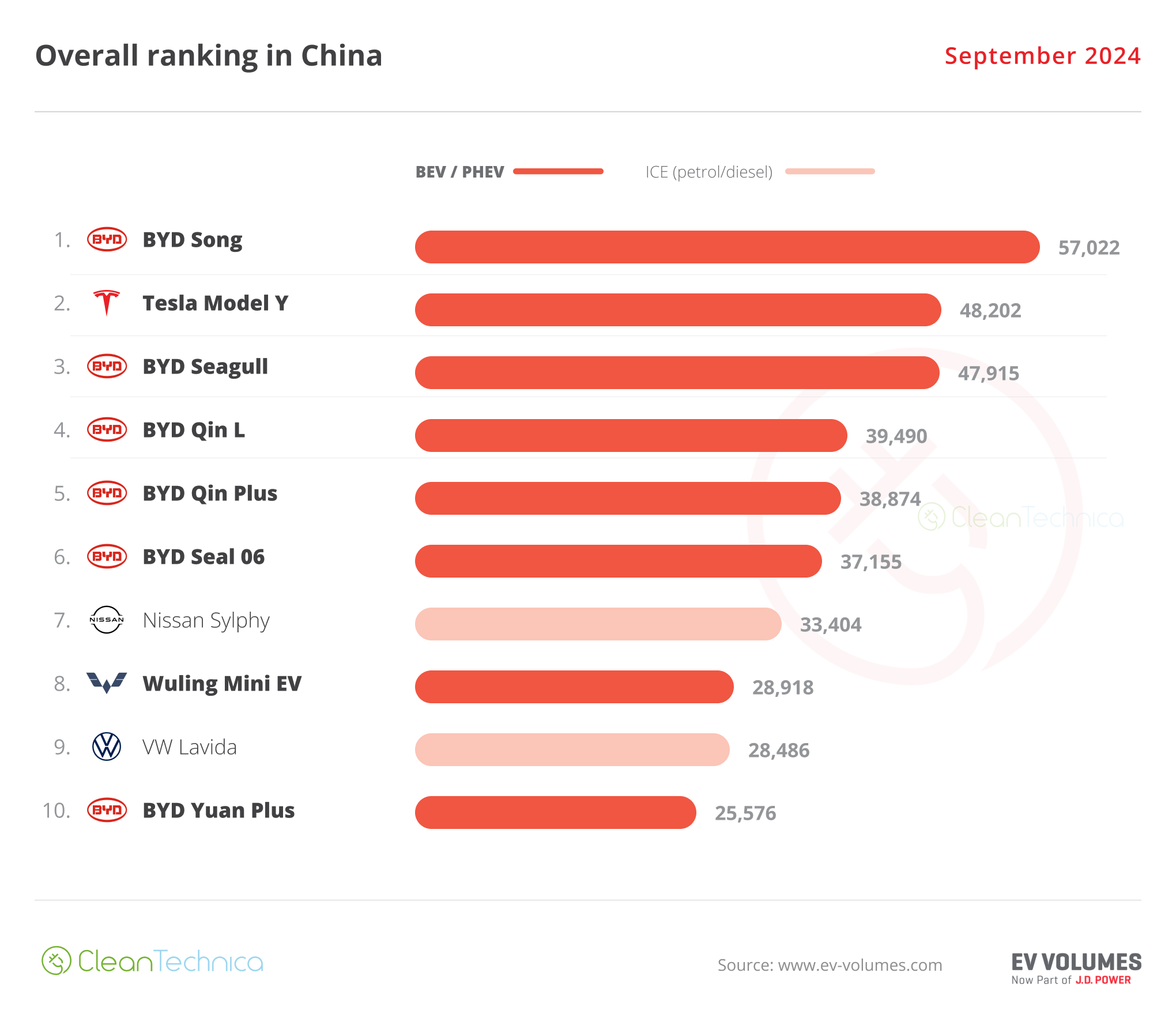Support CleanTechnica’s work through a Substack subscription or on Stripe.
Why you should buy an electric car!
An electric car is superior technology.
- If you’ve never driven one, you don’t know about this: They have amazing instant acceleration and are smooth as silk.
- Fewer moving parts (no complex internal combustion engine and transmission, so lower maintenance costs)
- No noise suppression (muffler) needed and no exhaust of noxious gases (no exhaust system, no emission control device)
- Little cooling needed: no big radiator, no water pump, and no anti-freeze
- More convenient for local driving: No oil changes, refuel overnight in your garage.
- Lower fuel cost for local driving: electricity ~1/3 the cost of gas for local driving
- No pollution while driving
- Tesla vehicles have optional AI (Artificial Intelligence) automated Full Self Driving.
Compared to another technology: Railroad steam engines were replaced by diesel electric engines (wheels driven by electric traction motors), and now diesel electrics have been replaced by pure electric engines for the US high speed Acela line from Washington DC to Boston (US commuter rail), and for almost all use in Europe and China.
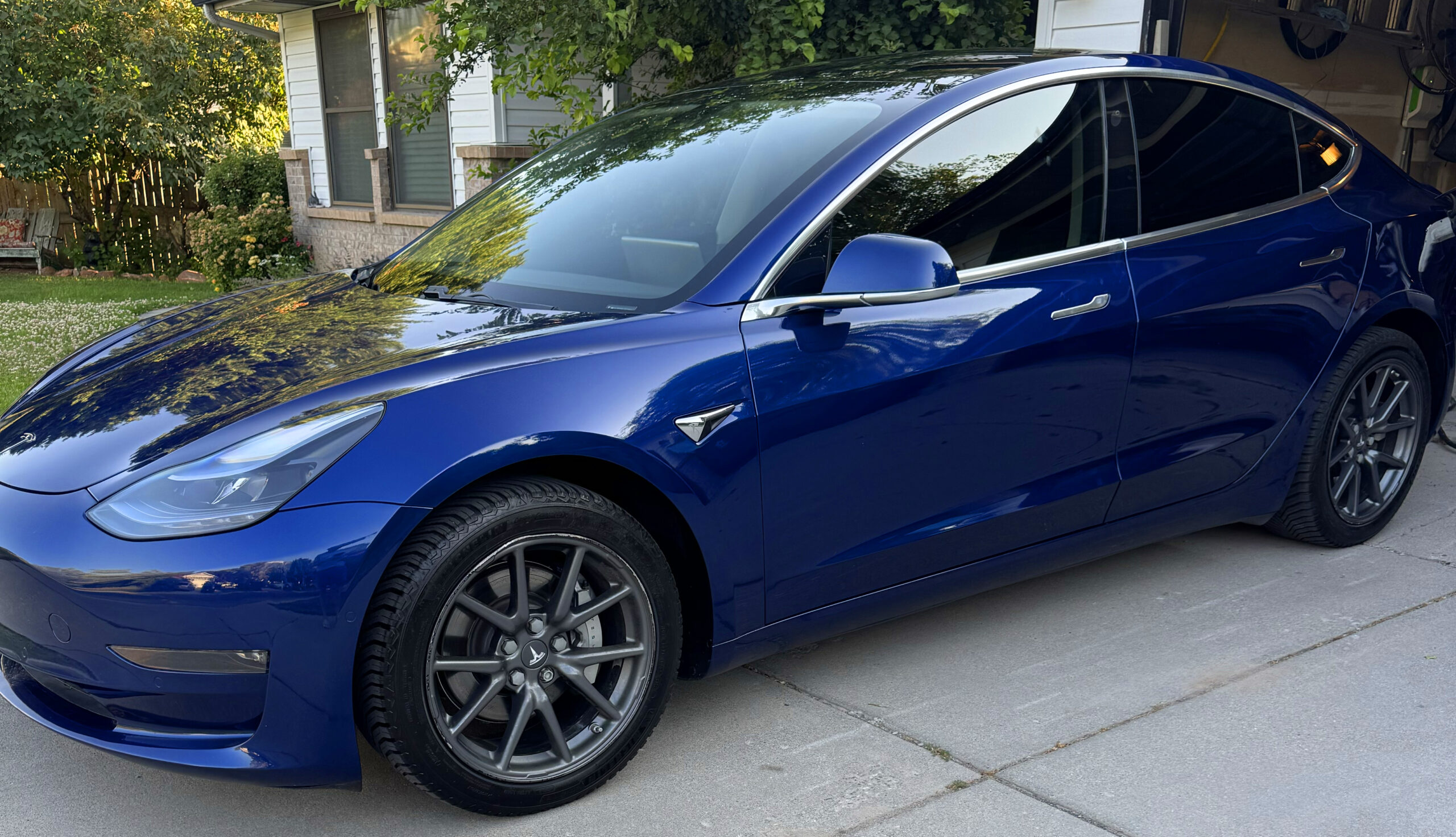
What to consider when buying an electric car:
- Why do I see so many electric cars swarming the roads today? Because so many people have found them to be superior to gas cars.
- Why are there so many two electric car families? They liked their first EV so much, they bought a second EV.
- Why do so many electric car owners swear they won’t go back to gas? Same reason.
- What about range anxiety? You can buy an electric car with 400 miles of range, and most EVs have a range of at least 300 miles. How many days to you do more than 300 miles of local driving? With Teslas there are Superchargers every 70 to 125 miles on all the major interstate highways in the US, so you never need to think about it. Other brands can now use most Superchargers, so you can do long distance driving with no planning,
- What about slow battery charging? If you are willing to take a break after 3 hours of driving, it only takes 10-15 minutes after your restroom break, dog walking break, or snack purchases.
- Will I have to replace the expensive drive battery? I’ve been driving my Tesla Model 3 for over 6 years and 165,000 miles. My battery still has significant range.
Can you afford an electric car?
- Base model Tesla is now $35,000.
- The new Chevy Bolt is $25,000.
- Used car lots are loaded with used Teslas starting at $15.000.
Do you need to buy a Tesla?
- Tesla has been selling electric cars for 17 years and has worked out most of the bugs in both the physical car and their software, which is still revolutionary today.
- Tesla has the most extensive charging network which is virtually 100% reliable. In California you will find Superchargers with over 100 stalls. You can drive on any Interstate in the US and find the next Supercharger within 70-125 miles
- The Tesla Model Y is the most sold car in the whole world and the Model 3 is second.
What to think about when buying a used Tesla:
- Is the 8-year, 120,000-mile warranty on the drivetrain and battery still in force (dual motor versions get the full 120,000-mile warranty)?
- Is it a dual motor version (essentially 4-wheel drive with upgraded sound system etc.)?
- Does it have Full Self Driving? If the owner paid $6,000-10,000 depending on the purchase date, it transfers with the vehicle.
- What version of computer and cameras does the vehicle have? HW3 was introduced early 2018. HW4 was introduced January of 2023. You can purchase Full Self Driving for $8,000 or $100/month. The full functionality of FSD will only be available with HW4. Elon Musk has promised a free upgrade from HW3 to HW4 to people like myself who purchased FSD. It will be very expensive for Tesla to do the upgrade, so I won’t be holding my breath.
So, you hate Elon Musk and don’t want to buy a sedan, Cybertruck, or a SUV that looks like a sedan. There are now many EVs and EV models sold by other manufactures available.
- Any EV that you buy will have amazing silky-smooth acceleration, a reliable electric motor, and at least 300 miles of range.
- All brands of EVs can use Tesla Superchargers, as you can see below. Many will even have Tesla charging sockets so you won’t need an adapter. Both Tesla and non-Tesla vehicles can be charged at NACS (Tesla Superchargers) or CCS chargers. Below you can also see a Mustang Mach E at a CCS Electrify America charger.
- However, at this time non-Teslas can only use the newer Tesla Superchargers, so there are gaps on Interstate highways where you can’t use a Supercharger. For example, all the Superchargers on I-80 in Wyoming are older versions that won’t support non-Teslas. With non-Teslas, there is some planning needed for cross-country travel. On the other hand, for local driving there is little advantage to owning a Tesla if you have charging, preferably level 2 charging, at home or at work.
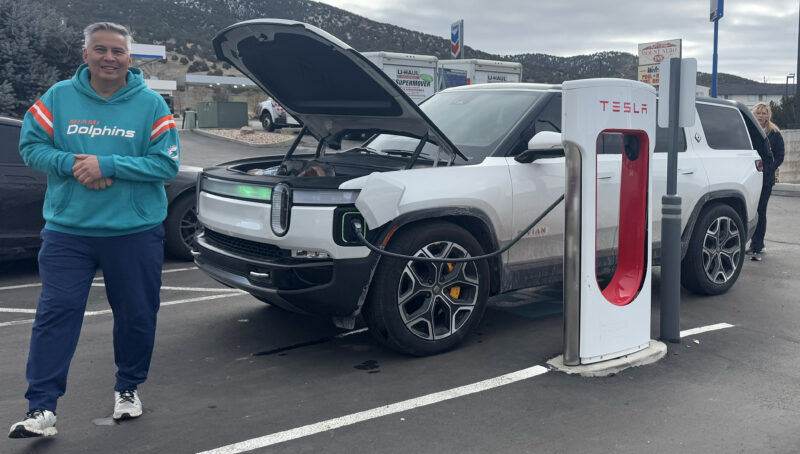
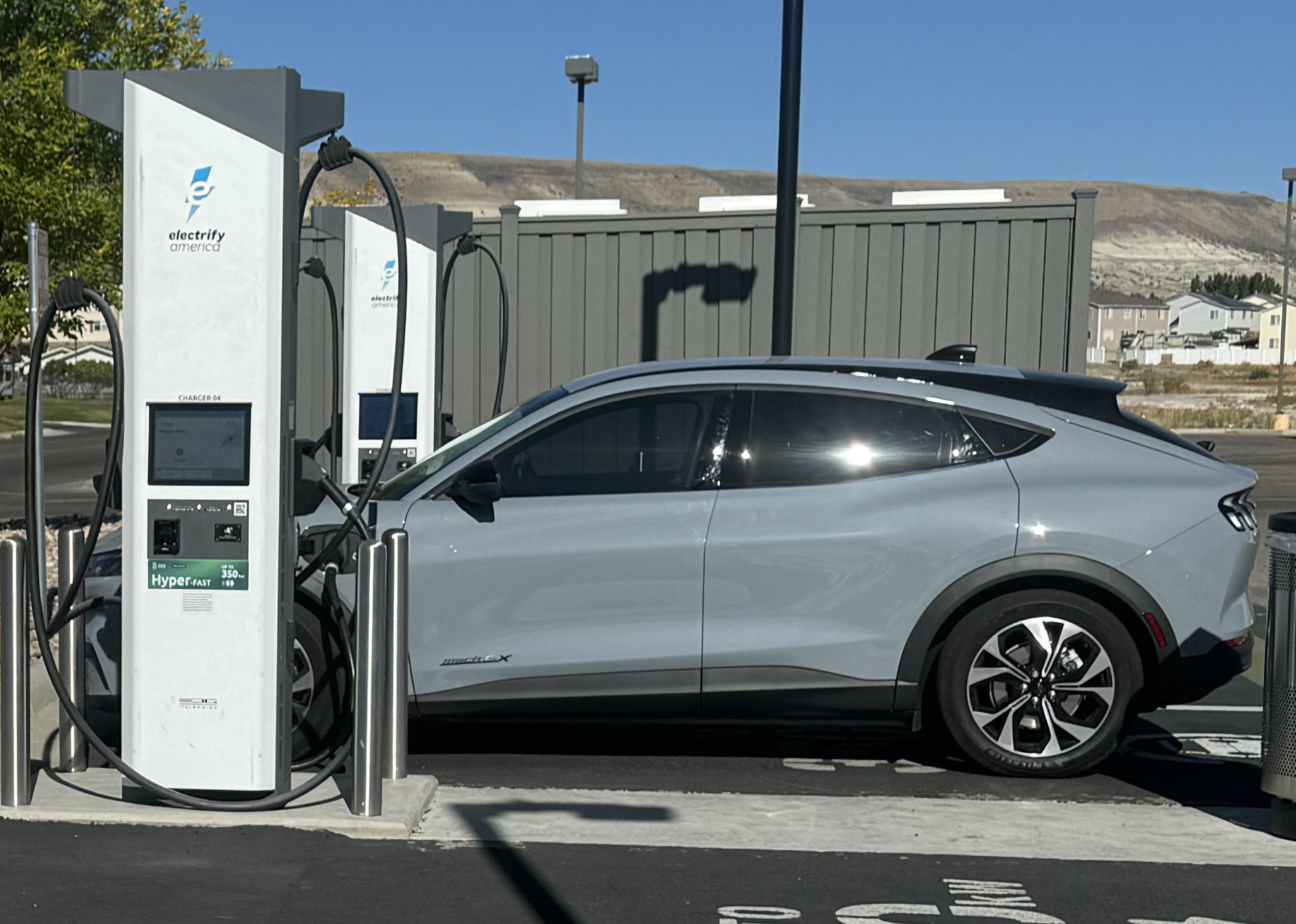
I drove Nissan Leaf BEVs for 5 years, and I’m now my driving my Tesla Model 3 dual motor BEV for over 6 years. I also benefit from the experiences of my brother who has driven his Tesla Model S for 6 years and now a Model Y for over a year, as well as my daughter who has driven her Tesla Model X for 7 years. My son purchased a used 2018 Model 3 which is working beautifully for 4 months.
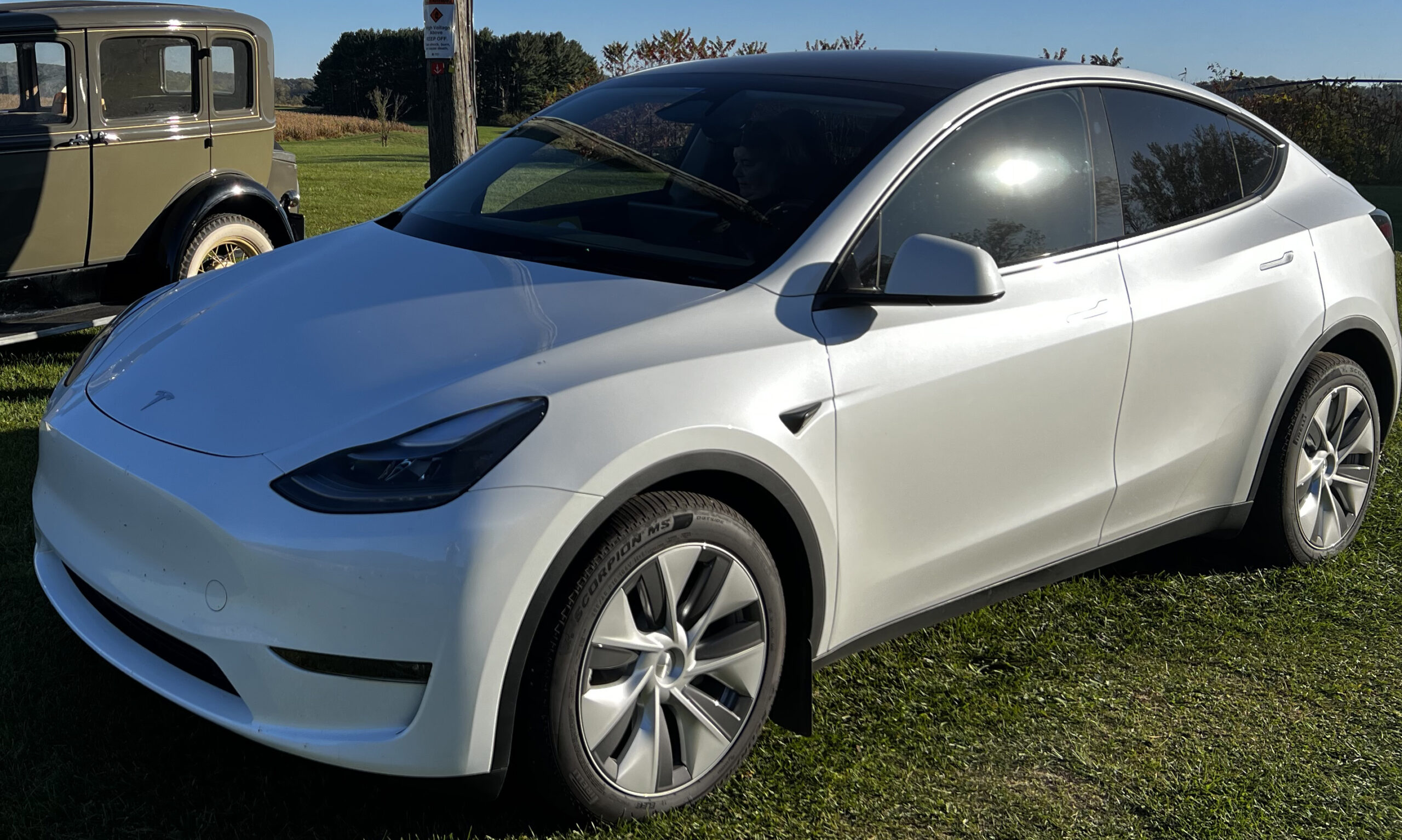
1) Battery-Electric Vehicles (BEVs) efficiently use clean energy and emit no pollution while driving: If you care about doing your small part in helping the world move to a clean energy future, your next car should be a BEV. A BEV uses a battery which is 90% efficient to drive an electric motor which is 90% efficient. A BEV emits no CO2 or particulate pollution while driving. I installed solar panels on my roof in 2015 so I have been driving on sunshine for 10 years. Coal power generation in the US is uneconomical and is being phased out. Meanwhile massive investments are being made in solar and wind power generation in the US. It won’t be long before the whole energy use pathway of a BEV in operation will be almost totally clean.
Every technology for transportation has some environmental impact, and BEVs are no exception. For BEVs it is the mining and refining of materials and the manufacturing of the batteries and the vehicles plus the disposal of the batteries and vehicle after use. The goal is to bring much of the mining and refining of battery minerals to humanely treated labor on shore. Also, companies have made huge investments in facilities for recycling of batteries which will reduce their environmental impact. A recent article explains how internal combustion engines emit voluminous particles smaller than 2.5 microns, which pass directly from the lungs into the blood stream. These particles have been estimated to reduce the life span of residents of highly polluted cities in Bangladesh and India by over 5 years. This effect is also observed in highly polluted cities in the US like LA and Chicago. Do your part to make the change to BEVs which will save millions of lives per year around the world.
2) When a BEV is more convenient! I think that most people who don’t drive BEVs think they won’t be as convenient as gas cars. I mean you can’t just drive to the nearest gas station and fill up in 5 minutes. Besides, unless you are driving some of the long uninhabited stretches in the American West, you can always find a gas station. Only farmers have gas pumps on their property, but most BEV drivers have a fueling station in their garage! For local driving, it never takes more than a few hours, or in the worst case overnight, to start the drive the next morning with a full battery. Also, how would you like to avoid sitting for an hour in the stinky waiting room at Jiffy Lube to wait for an oil change? BEVs never require an oil change. You will also avoid sitting in the stinky service station waiting room waiting for an emissions check. BEVs never need an emissions check. Also, the much simpler drivetrain of a BEV will require less service over the life of the vehicle. This means fewer trips to the dealer or service station for service and repairs. Bottom line: Most people do at least 95% of their driving locally. For local driving, a BEV is significantly more convenient than a gas car.
3) Driving your electric rocket-mobile (fun, fun, fun!): You know you are driving a BEV when you look to be sure that no one is pushing your car out of the garage by hand (you can’t hear a sound). My Tesla Model 3 Long Range Dual Motor has fabulous acceleration. You don’t need to buy the performance version or the Tesla Model S Plaid to get fabulous acceleration. I am a quite conservative 85-year-old, so I don’t use this feature very often. However, if you have been waiting long for a break in traffic at an intersection or want to pass on a two-lane road, you can do the dirty deed in an instant. You may also need to beat the car on your left at a stop light so you can make a left turn at the next intersection. I hate to admit it, but I also like to juice it for a few seconds to make sure I make the next stop light. You only need barely a hundred yards to pass a slow moving truck on a two-lane road. The acceleration is totally smooth and quiet, so you won’t call attention to yourself. I’m sure this is a disadvantage for some younger drivers.
4) Lower fuel and service costs: When driving an EV, you can laugh when you pass a service station with gas over $4 or $5 per gallon (in California). When charging at home, you will pay for electricity at about 1/3 the cost of gasoline. Also, electricity costs are very stable. It doesn’t vary like gas prices.
Here are ~30 things an internal combustion car has that a BEV does not: No Oil/Filter Changes, No Emissions inspection, No Transmission Flush/fluid change, No Radiator Flush/Antifreeze change, No belt replacement, No Tune-ups, No Spark Plug replacement, No Brake Pad Replacement (1,000,000 miles), No timing belt or chain replacement, No Water Pump, No Garage Deaths from CO Poisoning, No Oil, No Emission Control System. No Catalytic Converter. No Exhaust System/Pipes, No Muffler, No Gas, No Gas Tank, No Transmission, No Transmission Fluid, No Cooling System, no radiator or hoses, No Fan Belts etc., No Antifreeze, no complex ICE with max life ~200K miles, No starter, No alternator, No fuel injectors, Brakes last the life of the vehicle, LED headlights will last the life of the vehicle, and the electric motor should last 1,000,000 miles.
Driving my Tesla Model 3 for 165,000 miles, and my brother driving his Model S for 120,000 miles, I realize there are some repair items which are unique to EVs. My Model 3 has a battery/motor cooling system that failed and had to be replaced. My brother had to replace the front disc rotors on his Model S at 120,000 miles which had warped. My daughter has had to replace the glass roof on her Model X. Also, there are numerous electric window, seat, and mirror motors on my Model 3 which could fail. My car is almost a rolling computer. Who has had a computer with disk drives, screen, etc. that have lasted 20 years?
I almost forgot the elephant in the room. A replacement battery from Tesla for my Model 3 is $17,000. There are shops that will replace one cheaper. The warranty on my car for the battery and drivetrain is to 120,000 miles. At 6 years I’m at 165,000 miles, so I am going naked. I have been treating my battery with kid gloves. That means not charging over 80% or going down to near zero. I only charge to 90% in the morning before starting on a cross country trip. Usually, it doesn’t make sense to charge over 80% on a cross country trip because charging over 80% is very slow. It’s hard to get an accurate measurement of battery degradation. I asked my car for its current range and it said 250 miles. 310-250 = 60 miles, 60/310= ~19% battery loss at 164,595 miles. I’m 85 and I expect my battery to last longer than me.
On the other hand, I have spent over $3000 to rebuild a transmission, $2,000 on catalytic converters, and $1200 on 4-wheel drivetrain replacement on my gas cars. Also, I spent $16,000 rebuilding the V8 motor on my competition water ski boat twice in 18 years. My granddaughter was driving an older super reliable Toyota Camry, and it required a new timing chain and parts which would have cost $2500. We abandoned the car. She replaced it with a reliable Mazda 3. The timing chain failed on that car as well and we paid $1500 to get her back on the road. (Note: Timing belt replacement costs ~$200 but needs to be done every ~100,00 miles)
5) Driving a BEV cross country: If you have never driven a Tesla BEV, you may think there certainly aren’t electric charging stations at every exit off the Interstate like gas stations, so how can driving cross country in a BEV be convenient? 2 years ago, Tesla opened their 50,000th charging stall worldwide and has a fabulous chain of super-reliable charging stations at intervals of 70 to 120 miles on all the Interstates in the US. In a Tesla you touch the main screen in front of you and the locations of all nearby Superchargers come up. You touch the nearest most convenient Supercharger and it is automatically entered into the navigation system. The NAV then directs you to the charger, or if you have Full Self Driving Supervised it will automatically drive your car there. I have driven my Tesla Model 3 on the 1500-mile route from Wisconsin to Utah and back 12 times and traveled to both the east and west coasts. Over 6 years I have never found a Supercharger out of order and I had to wait for a charge only once and that was for 5 minutes. My brother routinely drove his Tesla Model S 85 D with a range of 245 miles cross country (he has since replaced it with a Model Y). A Tesla Model 3 Long Range like mine shown in the first photo has a range of 328 miles and a new Model S range is 405 miles. Some of the other brands have even longer ranges.
For non-Tesla BEVs, driving cross-country is more problematic. It’s a little like the early adopters of gas cars who had to hope to find a pharmacy that would sell them a few gallons of gas. I’m exaggerating, but non-Tesla chargers are not nearly as ubiquitous and are known to be out of order quite frequently. For non-Tesla drivers, you need to plan cross country trips more carefully. Also, the following non-Tesla manufacturers have native Supercharger (NACS) sockets in their BEVs: Aptura, Ford, GM, Rivian, Volvo, Mercedes, Polestar, Nissan, and Honda. I would be surprised if there are any BEVs that don’t have NACS sockets in the near future. Conversely, Teslas are able to use the other main (CCS) standard using an adapter.
6) They don’t make the model I like in a BEV version: This was true few years ago. However, there are now standard pickup trucks in EV versions like the Rivian, Ford 150 Lightning, and Chevy Silverado EV. The Tesla Cybertruck has been out now for two years. Tesla makes two SUVs, the Model Y and the Model X. Many other manufacturers like Mercedes, Kia, Hyundai, VW, Volvo, GM, and Nissan are making SUVs in BEV versions. Every year more BEV models are announced.
7) When a BEV is less convenient: If you don’t have your own off-street parking with 110V or hopefully 220V service, a BEV will be less convenient. If you have a longer range 300+ mile range BEV you will probably have to go to a fast charger once a week where you might need 30 to 45 minutes instead of the 5 minutes you need at a gas pump. However, many people can work online, or if you are a gamer or you want to watch a Netflix movie on the big Tesla screen, or you want to grab a bite to eat, you won’t be twiddling your thumbs while you charge. Also cannonball cross country runs in a BEV will take longer. My wife and I do the 1500 miles from Wisconsin to Utah in 3 days just like we did with our gasmobile. The 500 miles per day takes an hour longer, but the rest stops I need at 85, walking the dog, and grabbing a bite to eat means it’s little extra wasted time. However, my daughter made the 1500-mile run to Wisconsin in her Tesla Model X in 2 days, and after the last trip she was ready to trade in her car because it made each day significantly longer. She has kept the Tesla for local driving.
8) Where can’t you go in your BEV: We spend the summers in Northern Wisconsin. We like to go north to towns in the Upper Peninsula of Michigan on Lake Superior. There is a Supercharger near us in Minocqua Wisconsin and there are Superchargers in Duluth, Minnesota; Marquette, Michigan; and Escanaba, Michigan, on or near Lake Superior. There is also a new CCS fast charger in Ashland Wisconsin. It’s at Quiktrip gas station and even has NACS (Tesla) plugs. Tesla drivers need to be driving a model 2020 or newer or have their software updated. However, the whole Keweenaw Peninsula in the Upper Peninsula of Michigan is pretty much off limits to convenient travel in our Tesla Model 3. We can get there OK, but getting back requires an overnight charge at an RV park and you better have a camping spot reserved and a hotel very nearby to make it work. The North Rim of the Grand Canyon has a similar problem. Bottom line: With the planned massive buildout of EV chargers over the next few years by Tesla and others, many off-route locations should open up to BEV drivers, but for now beware.
9) What’s impossible with a BEV: The added air resistance from just hanging a bike or two on the back of your BEV will cut your range by ~40%. I know, because I travel cross-country with 2 bikes on my Tesla Model 3. I can still get from one Supercharger to the next, but I can’t skip any. If you want to tow a big wakeboard boat from Salt Lake City 10 hours to Lake Powell, you can pretty much forget doing it with a BEV. The Ford F-150 Lightning will pull that boat uphill like a dream, but your range will be cut at least in half and you might not make it from one charger to the next. Also, very few chargers are designed for pull-through charging, so you would have to unhook for each charge. There are now specialty Air Stream RVs that come with their own batteries that will let you have the same range in your tow vehicle that you would have with no trailer. However, the problem of no pull-through chargers will still be an issue. I think you can actually drive your Airstream BEV RV with a remote control so you can unhook and charge your RV and your tow vehicle separately.
Your Feedback
I would love to hear your comments and about your experiences in the comments section.
Referral Program
Tesla has reactivated its referral program. If you find any of my articles helpful to you, please use my referral link when buying a new Tesla: https://ts.la/arthur73734 (Be sure to use it when you make your order). If you are buying a new Tesla and use my link, you’ll receive $1000 off your purchase price for Model S and X, you will get $500 off for Model 3 and Y). You will also get 3 months of Full Self-Driving. It is technically FSD Supervised and it will drive you automatically to any address you enter into the Navigation. You will be getting the new Hardware 4 computer and upgraded cameras. This will enable running FSD V14. I’m getting multiple reports from family with newer Teslas that it’s amazing.
Sign up for CleanTechnica’s Weekly Substack for Zach and Scott’s in-depth analyses and high level summaries, sign up for our daily newsletter, and follow us on Google News!
Have a tip for CleanTechnica? Want to advertise? Want to suggest a guest for our CleanTech Talk podcast? Contact us here.
Sign up for our daily newsletter for 15 new cleantech stories a day. Or sign up for our weekly one on top stories of the week if daily is too frequent.
CleanTechnica uses affiliate links. See our policy here.
CleanTechnica’s Comment Policy




